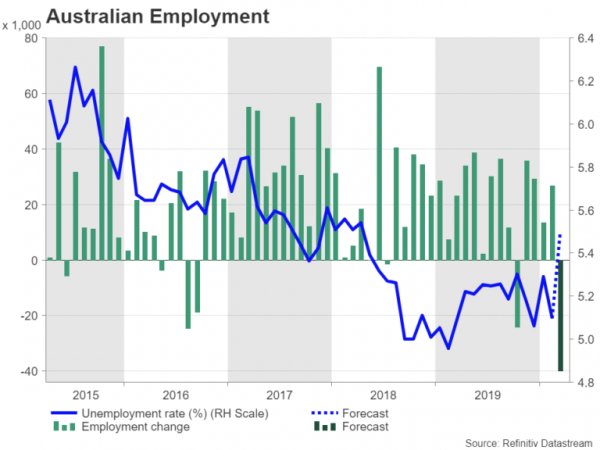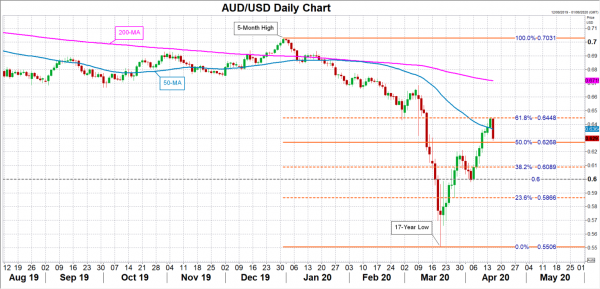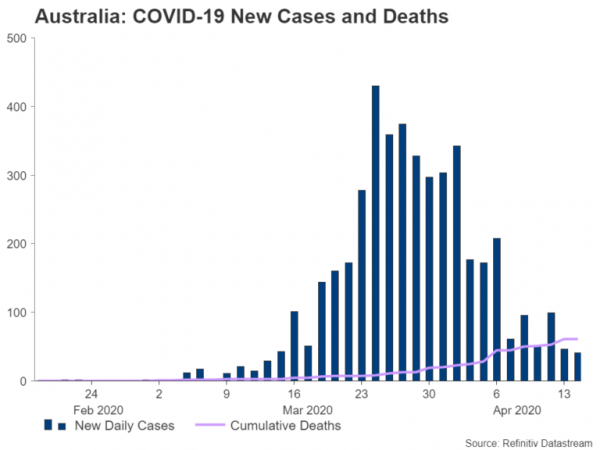As Australia enters its fourth week of national lockdown, the country looks set to find out what the economic cost of the virus shutdowns has been on the labour market. The employment indicators for March are due on Thursday at 01:30 GMT and are certain to make a grim reading. If the jobs numbers prove to be nothing short of disastrous, they could derail the local dollar’s recovery from the 17-year low it plumbed in March.
Jobless rate predicted to jump to 11-month high
Australia’s unemployment rate flatlined in 2019, having been on a downward trajectory since 2014. The trade war between its closest trading partner – China – and the United States and the consequent slowdown in global growth pushed the Australian economy into low gear, with GDP rising at the weakest pace since the 2008-09 financial crisis last year.
With the economy now battling a new and different type of crisis, there is only one direction the jobless rate can follow, and that is up. According to a Refinitiv poll, analysts are predicting the loss of 40,000 jobs in March – that would be the worst monthly drop since 2003. The unemployment rate is forecast to jump from 5.1% to 5.5%, which would be the highest in 11 months.
Dire jobs data pose a risk for the aussie
Such a large cull in jobs threatens to upset the Australian dollar’s astonishing rebound from its March trough of $0.5506 to around the $0.63 level currently. Aussie/dollar is already facing pressure from the mid-week increase in risk aversion, which capped the pair at the 61.8% Fibonacci of the January-March downslide. If the selling pressure intensifies, aussie/dollar is likely to slip below the 50% Fibonacci of 0.6268 and head back down to the 0.60 mark near the April swing low of 0.5978.
However, if the employment numbers are not as gloomy as anticipated and this coincides with an overall improvement in risk sentiment, the aussie will first have to overcome the 61.8% Fibonacci of $0.6448 to broaden its ascent.
Traders should be wary, though, of potentially a bigger risk event for the aussie this week when China publishes its GDP estimate for the first quarter on Friday, which will be important in setting the market tone, and in turn, the aussie’s path. At the moment, it’s easy to be dubious about the aussie’s strong rebound, just like many are questioning the sustainability of the relief rally in stocks, particularly on Wall Street.
Is Australia beating the virus?
However, it’s worth pointing out that, while Australia is hugely dependent on global trade and therefore vulnerable to developments elsewhere, the country is at least having better success than others in containing the outbreak of the coronavirus. The infection rate appears to have peaked in late March, and remarkably, Australia’s death toll stands at just 63, despite being one of the first countries to detect a case outside of China.
In addition, the Australian government has been quick to respond to the escalating virus fallout and its fiscal stimulus measures total 9.7% of GDP – among the highest in the world – while the Reserve Bank of Australia has launched several schemes, including an asset purchase program, to boost the economy.
In the short- to-medium term, as the pain from the virus is only expected to get worse and the RBA will likely be forced to add more stimulus, the risks for the aussie are clearly tilted to the downside. But looking at the other side of the tunnel, the Australian economy might be better placed to recover from this crisis than its peers, meaning better times ahead for the aussie.

















